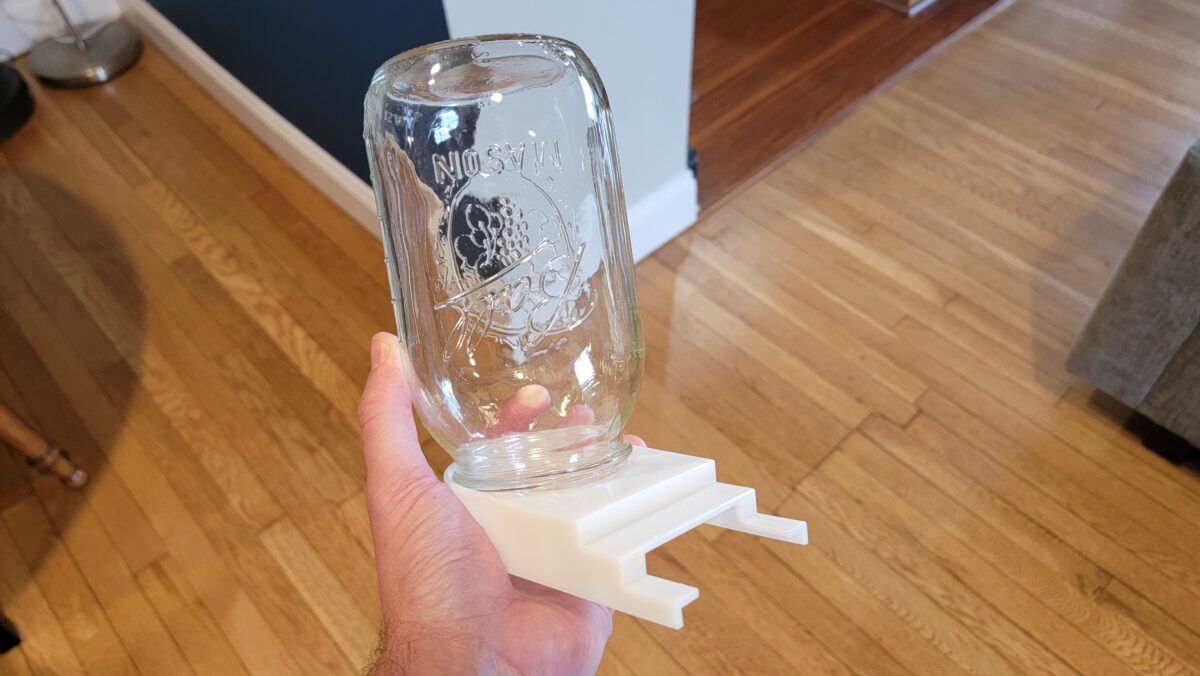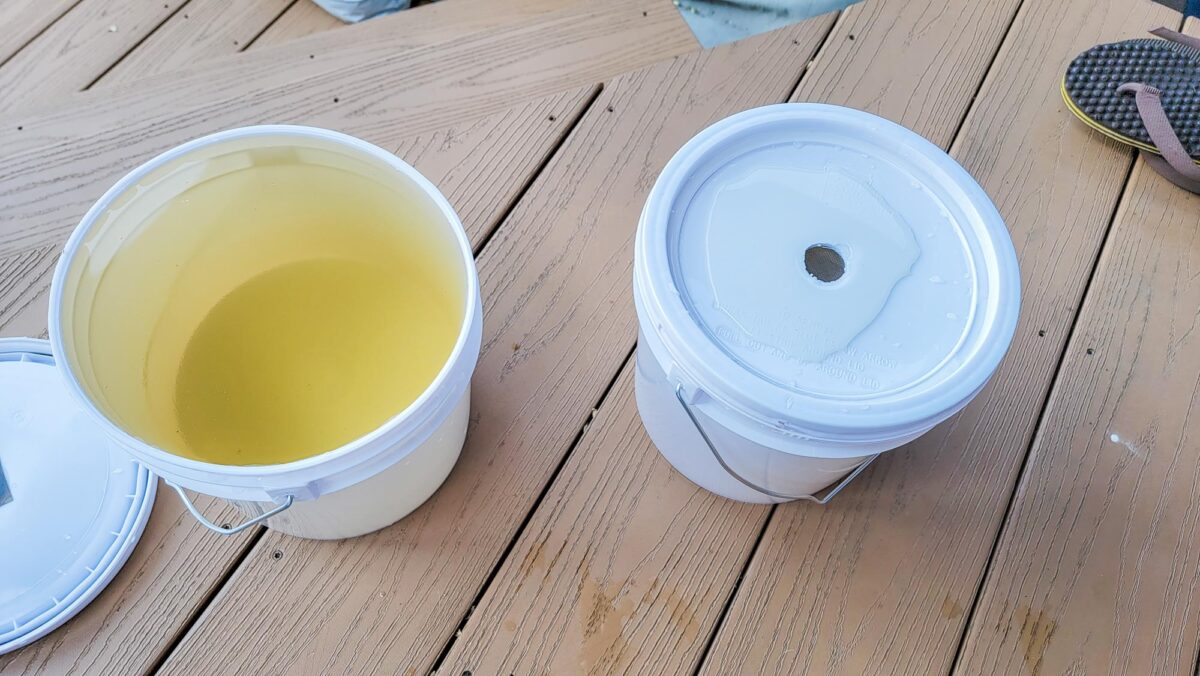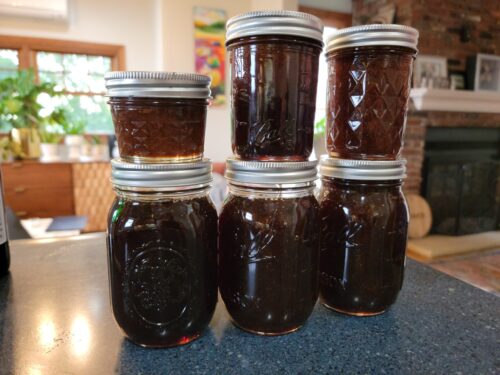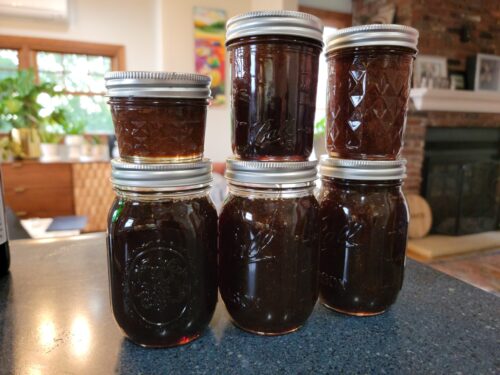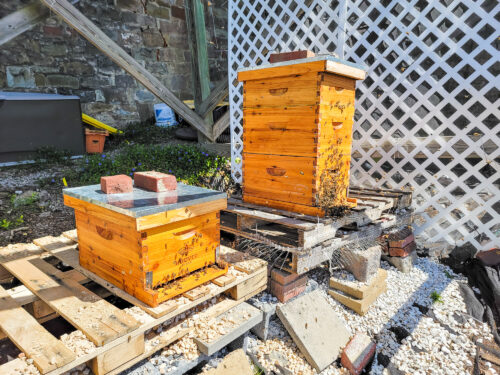Disclaimers: Our site uses demographic data, email opt-ins, display advertising, and affiliate links. Please check out our Terms and Conditions for more information.
It is obvious that bees consume honey as their primary food source. But we, as beekeepers, may not live in regions with enough nectar year-round to meet their needs. When this happens, bees have only one option- to deplete the stored honey in the hive.
This can happen when you have a new hive (as a package of bees comes with very little syrup and nucs may only have a frame or two of honey), during summer dearth (when nectar and pollen production goes down in local flowers), if a hive is struggling (such as when a queen dies and hive numbers decrease for a while), or over winter (where bees need somewhere between 50-100 lbs of stored honey to make it through to the following spring) to name a few.
Since we, as beekeepers, like to take excess honey for ourselves, any scenario that causes the bees to deplete their stores may delay or outright prohibit our ability to harvest honey when nectar is flowing abundantly. So many beekeepers turn to feeding their bees food, in the form of sugar syrup, to help get them to build up their stores and allow us access to harvesting that sweet, sweet honey when the time is right.
So in this one, we thought we'd share a bit more about feeders you may want to consider for your beehives, and why a simple top feeder may be the best option!
Why Feed Bees Sugar Water?
If you haven't worked with bees before, your first question may be about why we feed bees sugar water and not honey. The simple answers to this one are honey is expensive, and honey acquired from 3rd party hives may carry bacteria and other unwanted pathogens that could harm our colonies.
While feeding your bees their own honey may be okay, it is also the harvest we wish to keep for our own consumption. Supplementing with sugar water is by and large easier, safer, and perhaps most importantly, cheaper. A gallon of 1:1 simple syrup can be made with roughly five pounds of honey, or about $5-$8 depending on how much sugar is in bulk by you (bulk because you will use 10, 20, 50 lbs or more of sugar per hive per year), whereas a gallon of honey can be worth $75-$100 on the open market if you were to sell it.
Suffice it to say, simple syrup made of granulated white sugar is indeed the way to go (don't attempt to get fancy here, white sugar works just fine).
So whenever your bees are not getting enough sugar, feeding them a 1:1 mixture of syrup is the way to go. In the fall, as nectar flow winds down for the winter, beekeepers also like to feed their hives a 2:1 mixture of syrup just to give the bees a bit of extra sugar stored for winter.
The only times you wouldn't consider feeding bees are when the nectar flow is plentiful (and reserves are visibly increasing- although some still do to speed that process along) and when you have a super on to collect honey for harvest. The latter may result in what is known as “funny honey” which is a diluted sugar/honey mix that is not our intended goal for harvest.
So when you have decided it is time to feed your bees supplemental syrup, your next question is what device to feed them with!
- Fun fact: A bee consumes about 10 milligrams of dry sugar equivalent per day. At 50,000 bees per colony during the height of summer, this roughly ends up being about 1 L of syrup equivalent per day! Suffice it to say, if your hive isn't bringing enough nectar to meet its needs, you can see how reserves will be depleted rapidly without supplemental feeding.
The Best Feeders for Bees to Consider
When it comes down to it, there are three main kinds of feeders for bees that you should consider: an entrance feeder, a frame feeder, and a top feeder for bees. Each has its own pros and cons for use.
Bee Entrance Feeder
Bee entrance feeders are simple devices that are inserted into the front of your beehive. They are comprised of a glass jar, a screw-on lid with small holes, and an insert plastic piece that opens facing into the hive. Bees can come and go into the small entry space to take in sugar, and they are relatively easy to swap in and out due to their exterior positioning on the hive. (Note: In many cases, jars are not included with the feeders themselves.)
There are, unfortunately, several of negatives to this one worth keeping in mind.
First, most vessels for front feeders are simply small. You're likely not going to fit a gallon or two of simple syrup mixture into these, which means that your replacement rate will be much higher than other options. As more work is never a good thing, I opted not to use these purely on this account.
Second, any exterior sugar, even at the hive entrance, may attract unwanted pests (read: ants, other animals, etc).
Finally, you may experience hive robbing. This happens when bees from other colonies attempt to access your hive to steal the precious resources your bees are working hard to build (i.e. honey). This is especially risky when nucleus colonies are installed in new hives as your bee population is quite low and may not have the volume built up to defend themselves. So what many new beekeepers find happens with these is that outside bees come in, steal the sugar mixture, and abscond with it back to their own hive!
Suffice it to say, while these are generally deemed to be the easiest to use, the negatives seem to outweigh the benefits.
Frame Feeder for Bees
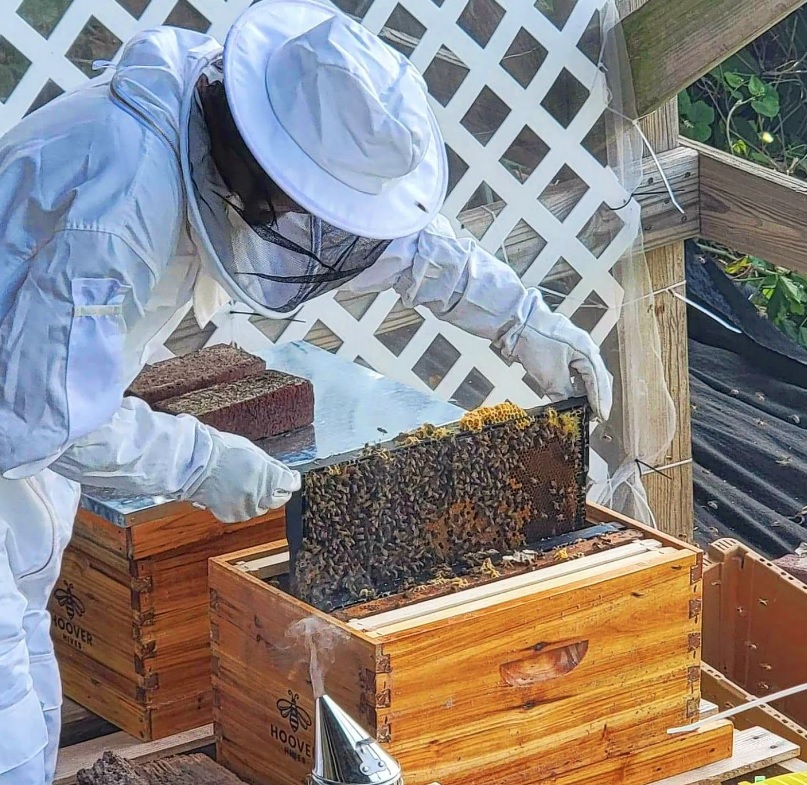
Bee frame feeders sound exactly like what you'd think from the name. These are faux frames that you can fill with up to a gallon of simple syrup that allow bees to feed off of them from within the brood box itself.
While these contain much more volume than most entrance feeders, allowing for longer durations between refills, there are plentiful downsides to these as well.
First, unlike the entrance feeders, you do need to access the hive completely to refill these. Some cautious beekeepers may find it unappealing as you may want to check on sugar consumption more than the normal inspection interval (which for us was about every 10-14 days early on). The more you check on your hive, the more the bees may get defensive, and you'll have an increased likelihood of stings.
Second, seasoned beekeepers believe that bees will not consume sugar from these as much in the winter as they like to huddle together for warmth. The further they have to travel to get to food, the less likely they are to do it when temperatures drop. We have not tested this theory firsthand, but we believe it.
Finally, as a personal decision, we didn't want to remove an extra frame for brood from our eight-frame Langstroth hives. One lost frame seemed like too much proportionally when it comes to monitoring hive space, so we left the space for the bees to do what bees do best. Would we consider a feeder like this on a double chamber in the fall? Maybe. Or if we had a 10-frame hive? Certainly. But it seemed like a risk not worth taking here.
Top Feeder for Bees
Finally, we come for top feeders for bees. These are the most interesting of the three and among the safest and easiest to use
These feeders can come in different forms, either via an exposed feeding system where the syrup rests in a large surface area for bees to access (from above) or simply via an inverted pale that allows syrup to be accessed from a mesh-covered hole (from below)- note the latter can be made DIY or procured at a local bee store.
The exposed feeders are straightforward and easy to set up. You fill the reservoir with simple syrup, put it in a deep brood box without frames, put on the cover, and let bees access the feeder as needed. While easy for refilling and checking (you only have to take the top cover off and not get into the frames themselves), many beekeepers have pointed out that depending on the model of unit you have, the reservoir may be quite deep and could cause bees to drown in the syrup outright.
As I want to avoid inadvertently killing my bees, even just a few, I went for the inverted pale feeder system instead. This one is simply a one-gallon pale with a hole in the lid (typically covered with a fine mesh) that you fill with sugar water, flip upside down and place over the hole in your inner cover. We then put an empty brood or super box around this and replace the top cover as usual.
Now, you may ask, won't the syrup just drip out everywhere if the hole on the bottom of the pale (you may have had this question with the entrance feeders, too)? The answer to this one is simply fascinating.
As it turns out, viscous syrup in a 1:1 mixture can exploit a cool physics feature you may not recognize off-hand. When the pale is full (and we're talking completely full here) and you flip it quickly, only a little syrup will come out (do this near your hives angled towards the ground- you'll lose a few tablespoons which will become quite sticky until the bees clean it up). As the syrup drips out, a vacuum gets pulled at the top of the feeder.
When this happens, the fine mesh screen mentioned above comes in to hold enough surface tension to prevent any further drips. This allows the bees to fly up to the pale entrance as they please, sip syrup as needed, and slowly drain down the feeder over time- all while having the sugar 100% angled into the hive itself.
But if you go this route, be sure to buy a pale feeder that is designed specifically for use in bee hives- namely food-grade plastic (for any feeder, that is) and with a mesh covering in the hole. Otherwise, you may see more drips into your hive which could waste sugar unnecessarily fast and, like other feeders, possibly attract ants as well!
The downside to these feeders is that you will still need to access your hives to check on these. This may (or should) involve wearing full protective gear and smoking your hives for safety. That being said, at one-gallon capacity we often can wait until our next normal inspection.
Overall, as I want to have as minimal intervention in my hives as possible, all while preventing pests and hive robbing, the answer was pretty simple to me- top feeders are the way to go. But whatever you choose may be influenced by your own scenario, and thankfully you have a number of reasonably priced options at your disposal to consider!
Do you have a preferred way to feed your hive syrup? Comment below to share!
Start an Apiary Today
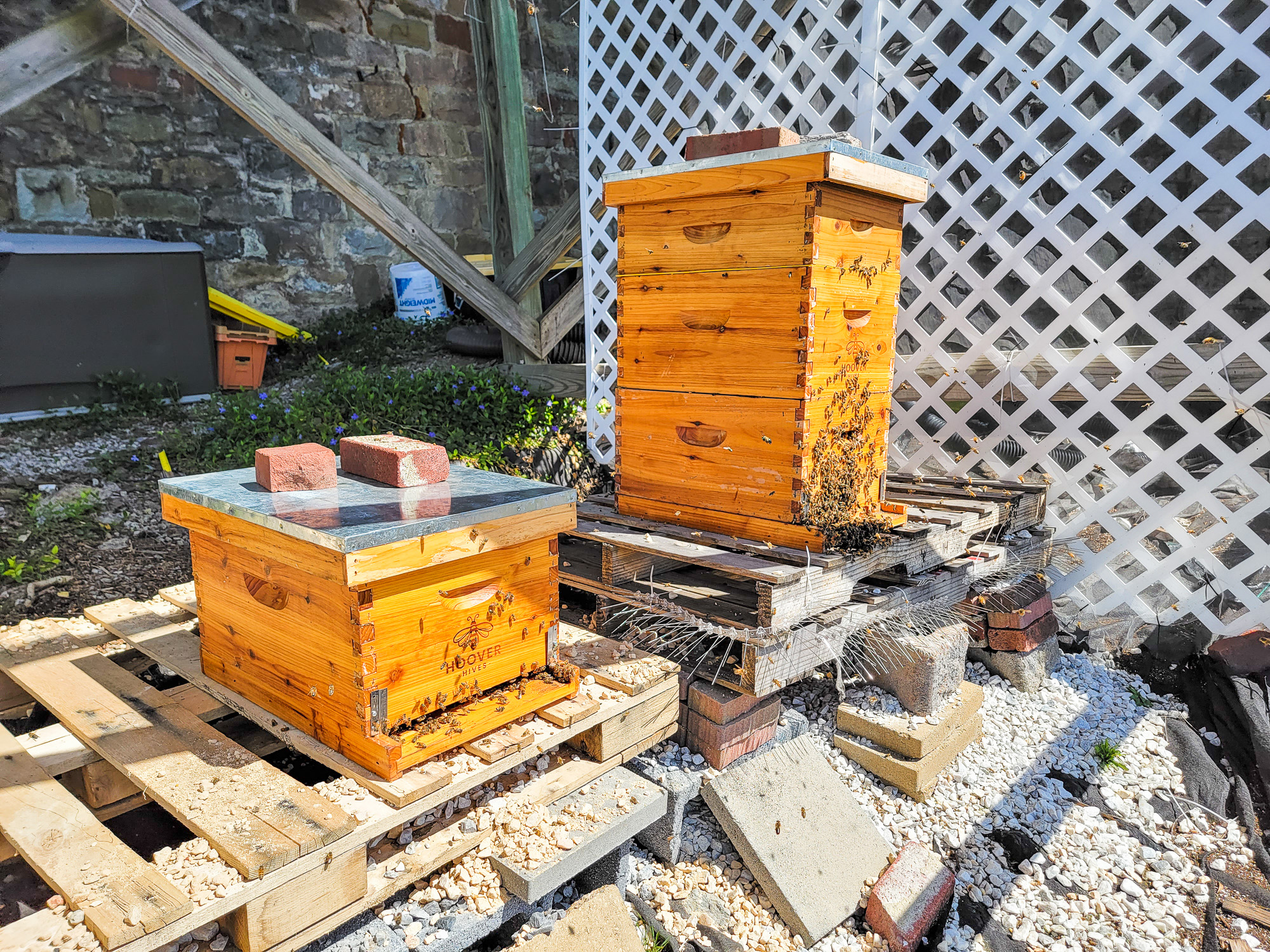
Looking to get into beekeeping? Pick-up preassembled waxed Hoover Hives from Galena Farms. Use discount code HIPSTERHOMESTEADERS to take 5% off your order!



